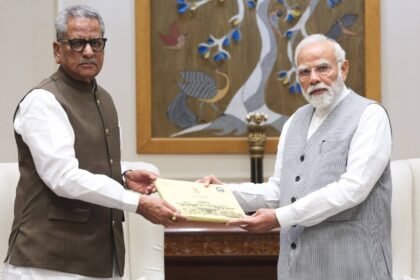GYALSHING: The State-Level Sakewa Festival 2024, a vibrant celebration of the Rai community’s rich cultural heritage was observed with festivity at Tathang Village under Yuksam-Tashiding Constituency in Gyalshing District on November 20.
Organized by the Akhil Kirat Rai Sangh (AKRS), the festival highlighted the unique traditions, language, and customs of the Rai community, celebrating their invaluable contributions to the cultural heritage of Sikkim.
The Chief Minister of Sikkim, Shri Prem Singh Tamang, graced the occasion as the Chief Guest, accompanied by Madam Krishna Rai.
The festival was a vibrant showcase of the Rai community’s culture, featuring mesmerizing cultural performances, ethnic costumes, traditional food stalls etc. Attendees also explored exhibitions of traditional Rai literature, cuisine and handicrafts, gaining a deeper appreciation for the culture’s rich traditions.
Addressing the gathering, Chief Minister Shri Prem Singh Tamang extended warm greetings on the occasion and commended the community’s dedicated efforts in preserving and promoting their unique cultural identity. He reiterated the state government’s commitment to supporting initiatives aimed at safeguarding the rich cultural heritage of the state while fostering inclusivity and harmony among all communities.
The Chief Minister highlighted that the Yaksum-Tashiding constituency has recorded the highest number of employment appointments, emphasizing the developmental initiatives undertaken in the area. He informed the gathering that the construction of houses, the distribution of GCI sheets, and the allotments for homestay construction, which were distributed before the election, will be provided shortly as the required budget has already been sanctioned.
He also shared details of the government’s health initiatives, including partnerships with leading hospitals across the country, wherein the government will cover the costs of treatment.
Emphasizing the non-political nature of the Akhil Kirat Rai Sangh (AKRS), the Chief Minister clarified that it is a non-profit organization solely dedicated to the community’s development. He assured that all demands submitted by the AKRS have been duly acknowledged and progressed for the welfare of the community.
Addressing the shortage of Rai language teachers in some schools, the Chief Minister encouraged applications from candidates, assuring priority to applicants from the region. He also proposed organizing a three-day convention focusing on the development of the Rai community to facilitate in-depth research and formulate welfare measures.
In response to AKRS’s demand for the construction of a Rai Khim in Gyalshing District, the Chief Minister assured its inclusion in the upcoming supplementary budget. Additionally, to promote cultural preservation and upliftment, he announced the appointment of Shri Mani Das Rai as Officer on Special Duty (OSD) in the Cultural Department for Rai Language.
The Chief Minister also raised concern over the declining birth rate in the state. He highlighted government initiatives, including additional increments for employees with two or more children and financial assistance of up to ₹3 lakhs for IVF procedures.
In conclusion, the Chief Minister assured the people of the constituency of a public interaction program to be held in December.
The Chief Guest also unveiled the annual calendar of Akhil Kirat Rai Sangh followed by Khechuperi Archives – Platinum Jubilee Special Issue school magazine and a book titled Hamro Pahilo Kadam, authored by Devi Ram Rai and Numa Koyu Rai and published by Mr BS Panth.
The Sakewa Festival holds immense cultural significance for the Rai community, with Ubhauli Sakewa officially recognized as a restricted holiday for government offices, PSUs, and educational institutions in Sikkim.
The event concluded with attendees celebrating the spirit of togetherness, leaving with a renewed appreciation for the Rai community’s traditions and values. The Akhil Kirat Rai Sangh was commended for its efforts in organizing such a grand and inclusive celebration, reflecting Sikkim’s rich cultural unity.
- IPR Report





